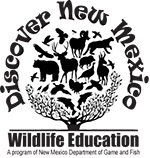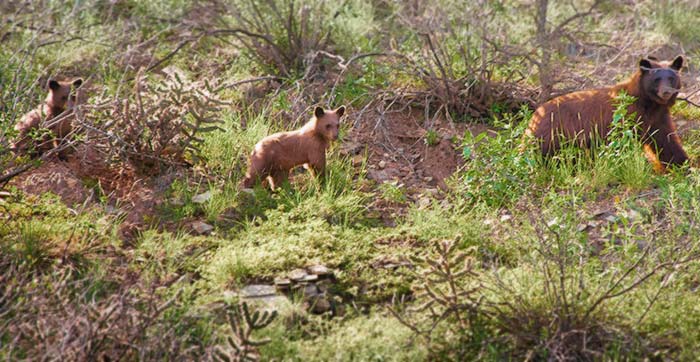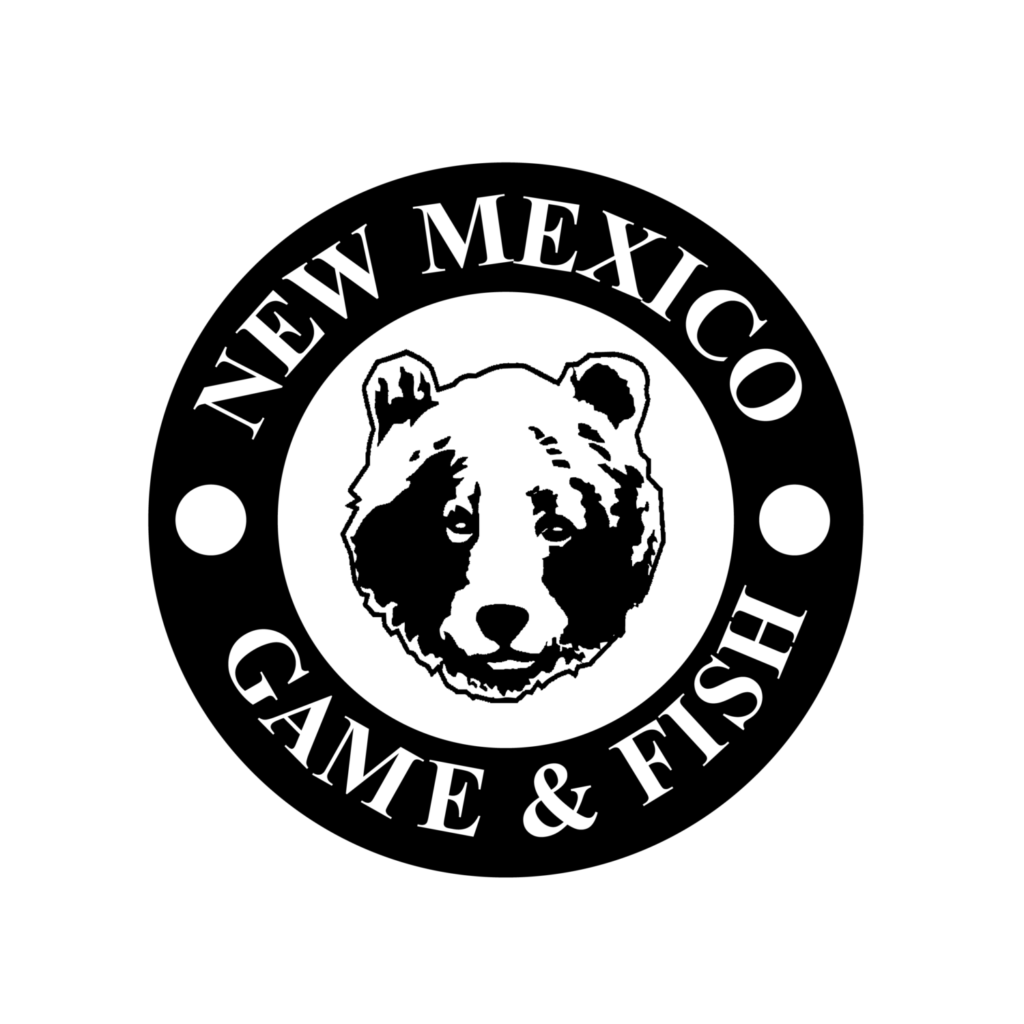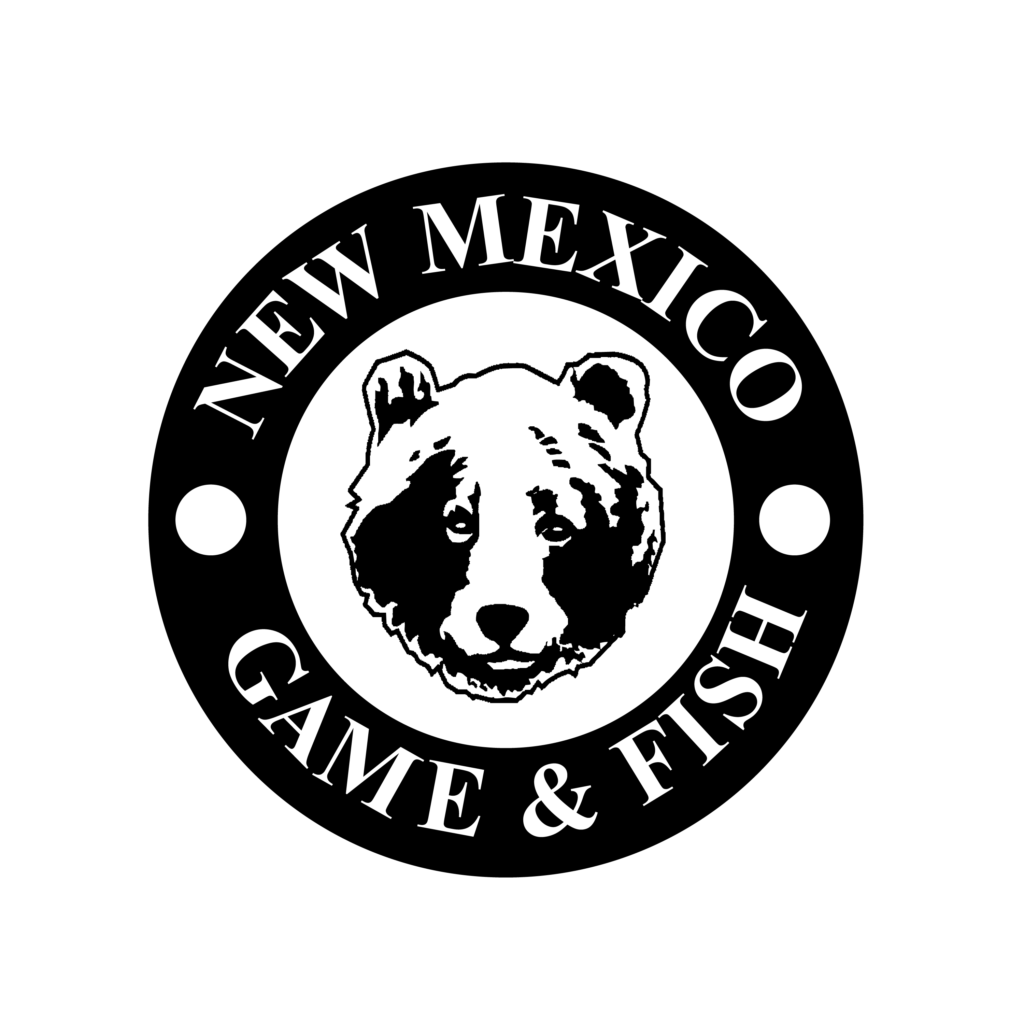
Growing Bears in New Mexico
Students learn about black bears in New Mexico while engaging in mathematical calculations.
Overview

New Mexico black bear with cubs.
Overview: Students learn about black bears in New Mexico while engaging in mathematical calculations.
Grade level: 4th-7th grade
Content Areas: Science, Math, Expressive Arts
Objectives:
- Students will understand basic black bear biology,
- How to calculate percentages, create a line graph, engage in abstract reasoning and problem-solving,
- And use graphs, tables, pictures and equations to understand different patterns of change related to black bears and humans.
Method: Students read about black bears, learn about black bear biology, answer questions about black bears, and write in their science journals. Students use actual data from Southwestern black bears to make mathematical computations and draw comparisons between themselves and black bears. Students illustrate, compute and graph differences between people and black bears at various stages of maturity.
Materials:
Graph paper
drawing paper
copies of student data pages and chart comparing students to a black bear
bathroom scale for weighing,
cloth tape measure
yardsticks.
Lesson and Activity Time: One or two 45-50 minute classroom sessions depending on how deeply students explore.
Location: Indoors
Common Core Standards:
Mathematics:
Grade 4: Measurement and Data-MD.1,2,4.Grade 5:
Number and Operations-Fractions-NF.2,3,6,7c.
Measurement and Data-MD.1,2.
Geometry-G.1,2.English Language Arts/Literacy Skills:
Grade 4:
Reading Standards for Informational Text-RI. 1,3, 4,7.
Writing Standards-W.4,6,7,8,10.
Language Standards-L.1,2,4b,4c, 6.Grade 5:
Reading Informational Text-RI. 7.
Speaking Listening-SL.5.
New Mexico Science Standards:
Strand II: Content of Science, Standard II Life Science.
4th grade Benchmark 1.1.
Background
Vocabulary: adaptation, cavity, camouflage, competitor, circumference, dormancy, digitigrade, embryo, habitat, hibernation, herbivore, omnivore, navigate, plantigrade, stationary, torpor
Background Information – Black Bear Biology:
Note: A more condensed summary is the Wildlife Note: Black Bear.
People who live in New Mexico are lucky to share their forests with black bears (Ursus americanus). Bears are generally very wild, secretive animals that will run away if they see you. If they become food-conditioned and associate people with food they can become a nuisances. This happens when people carelessly leave garbage, pet food, or bird feeders accessible to bears. If a bear loses its fear of humans in this situation, it often loses its life because it must be killed before it hurts someone.
New Mexico’s black bears are creatures of the forest. Camouflaged by its brown or black fur, a black bear easily fades into the shadows. It can move quietly on its soft, broad foot pads. Bears walk on their feet as humans do, with their soles flat on the ground-this is called plantigrade. Most other mammals, such as cats or dogs, walk on their toes-this is called digitigrade. Black bear tracks are about 8 inches long and have a curved line at the front of the front pad. Being able to navigate the forest quietly and unseen helps a bear avoid other bears as it searches for food. If a young bear accidentally runs into a large adult male, who could consider the youngster a competitor, the younger animal needs to retreat before it is discovered. Male black bears will occasionally kill and eat other males in their home range! If necessary, bears can run 30-40 miles an hour for short distances or paddle across a lake.
In the forest, bears rely on their acute hearing and super sense of smell to gather information on the world around them. Their noses perceive smells much fainter than humans can detect. With their incredible sense of smell, they can detect other animals nearby, and find carrion (dead animals), fruit, insect larvae and other food. Bears can also see what goes on around them, probably as well as humans can. Their sharp color vision helps them find lots of food on the ground. They observe moving objects better than stationary objects, which helps them hunt.
Grasses and sedges
Forbs (broad-leaved plants) and shrubs
Mushrooms
Elk calves and deer fawns
Ground squirrels and other small rodents
Ants, wasps, bees (adults and larvae) and yes, honey!
Carrion (dead animals)
Prickly pear fruit and any fallen orchard fruit
Nuts! Especially acorns and piñon nuts
Berries! Juniper berries, gooseberry, chokecherry, and hawthorn berry are favorites
And of course, if bears lose their fear of humans they will eat whatever they can find; garbage, dog food, bird food, poultry, livestock etc.Approximately 75% of a black bear’s diet is based on plants and 25% on meat-which includes carrion and insect larvae.
Bears become adults around 3-4 years of age and depending on their age and size they can mate in May and June. Although bears mate in the spring, cubs are not born until the following winter. Female bears that are expecting cubs use their stored body fat to grow the developing embryos. She gives birth in the den to an average of two cubs every other year (at the most). Cubs are born in late January or early February. The cubs are helpless when born, their eyes are closed, and their thin fur is not enough to keep them warm. On average they weigh 8 ounces. For humans an 8-pound baby at birth is about 7 percent of the weight of a 120-pound mother. A newborn bear cub is just a fraction of 1 percent of the mother bear’s weight! When a cub greets the outside world in late April or early May, it weighs 4 to 10 pounds and is usually strong enough to climb trees. They eat some solid foods but they depend on mother’s milk throughout the summer to help it grow strong and ready for winter hibernation. At the end of their first year they weigh an average of 40-45 pounds. Cubs usually den with their mother the first year.
How Big Is a Bear?
The size of a bear depends on who you talk to, but you can be sure that a bear spotted in the wild rarely weighs as much as we think it does. Researchers who study black bears say bears usually weigh half what people estimate. So that “400-pound” (180 kg) bear someone saw in New Mexico probably weighed less than a college football player. Males average 5 ½ feet in height when standing on their hind legs. Females are around 4 ½ feet tall.
Black bears go into a deep sleep (torpor) during the winter in New Mexico as an adaptation to conserve energy when it is cold and when food is harder or impossible to find. In the den bears do not eat, drink, defecate or urinate while in their deep sleep. Adults save energy by lowering their metabolic rate by up to 50%. Their heart rate goes down from around 40-55 beats a minute to 20-25 beats a minute. Their heart rate can go even slower for short periods. There can be up to 14 seconds between heartbeats! Their body temperature goes down to 47 degrees Fahrenheit. Although bears are definitely in a deep sleep they can still be woken up and aroused. This allows a bear to protect itself or its cubs from predators invading the den. By the end of the winter they may lose about 20-30 percent of their body weight.
Bears in New Mexico begin to enter dens by October 15, and a few bears do not enter dens until after December 1st. In the spring, most bears are out between April 1 and May 1. In general, female bears enter dens earlier and emerge later than males.
Black bears either dig out their dens or use natural openings such as hollow logs, tree cavities, holes dug into hillsides or under rocks or boulders, or under the base of stumps, trees, or logs. Bears will also use human-made structures such as drainage culverts, and basements or foundations of buildings. Most dens, are surrounded by dense vegetation which helps hide the entrance. Females seem to prefer tree cavity dens when they are available.
Most bears build nests within their dens. Nests are built out of nearby plant materials (vegetation) such as pine needles, twigs, leaves, and grass. Most all bear dens are reused in following winters. Dens are most common in mixed conifer and spruce fir habitats in New Mexico but are also found in ponderosa pine forests and piñon -juniper woodlands.
Even though about 5,000 bears live in New Mexico, people seldom see them unless they are careless with their food sources or they go hunting. Black bear hunting opportunities are offered around the state. For many sportsmen, pursuing bears is an exciting form of recreation as well as a method for managing a healthy population. In 2012, around 2,300 black bear hunting licenses were sold in New Mexico with approximately 550 hunters harvesting a bear.
Although bears can live up to 20-25 years in the wild, the average in New Mexico is around 7-8 years.
Black bears are aged by pulling a small tooth (they have 42 teeth as an adult) and cutting it in half and counting the rings.
Newborns
Average is 8 ounces (0.23 kg) = only 1/2 lb.,
This is about the weight of two sticks of butter
Cubs- starting at 4 months
5–30 pounds (2.3–13.5 kg)
One-year old bears
25–100 pounds (11.3–45 kg)
Average is 40-45 pounds
Mature Females (4 + Years)
90–235 pounds (40.5–105.8 kg);
Average is 130 (58.5 kg)
Mature Males (4 + Years )
150–400 pounds (67.5–225 kg);
Average is 250 pounds (112.5 kg)
(For more in depth information on black bears in New Mexico please see [wpfilebase tag=file id=1895 tpl=filebrowser /], by New Mexico Department of Game and Fish).
Procedure
Lesson – Preparation:
- Contact New Mexico Department of Game and Fish, Conservation Education to borrow the Black Bear Critter Box.
- Using Black Bears of New Mexico: An Educator’s Guide, Black Bear Wildlife Note, and the hides, skulls, claws and other materials in the Critter Box, discuss what they know about black bears..
[wpfilebase tag=file id=1500 tpl=simple /]
- Students record the questions they have about black bears in their science journals or on shared social media sites for the whole classroom to read.
Lesson – Procedure:
- Continue a class discussion with the students about black bears. Find out more of what they know and want to know about black bears in New Mexico.
- Distribute the Student Background –Black Bear Biology page and New Mexico’s Bear Facts! How Do You Compare?, and Average Height to Weight Chart for United States Youth charts*. Working in small groups, have students use the information on black bear life history and biology to help them complete the New Mexico’s Bear Facts! How Do You Compare?
[wpfilebase tag=file id=1478 tpl=simple /][wpfilebase tag=file id=1479 tpl=simple /][wpfilebase tag=file id=1477 tpl=simple /]
*NOTE: Pediatricians use the chart above to see if kids are on track for their age group…of course, some kids are larger and are in the upper percentile of their age group and some are in the 1% group being the smallest kids on average for their age.
- Working in small groups and using their science journals, ask students for their ideas on the following:
- Where they might find black bears in New Mexico,
- How long female black bears are pregnant,
- What bear cubs might eat in New Mexico,
- When they are born,
- How much they weigh when they are a year old,
- How many cubs might be born at the same time,
- How much they weigh when they are full grown, and
- How long they live
- After they finish, then provide students the table, Weight and Age Relationships for Black Bears for them to complete. Students will be calculating percentages and averages. To help them they can use, Average Height to Weight Chart for United States Youth.
[wpfilebase tag=file id=1476 tpl=simple /]
- Ask students to take this information and create a line graph.
a. Students plot average child’s weight in the United States at the same ages as the black bears (birth, 4 months, 2 years, etc.) shown on the table.
b. Ask students to continue and graph (could use a bar graph) the black bears weight gain (have them choose male or female). - Ask students to compute the following, and include their results with their graph:
a. How much weight did the black bear gain at each interval- that is, from birth to 4 months, 4 to 8 months, etc.?
b. How much weight does the average healthy child gain during the same intervals? [see Table A] Students can use the data for their own gender.
c. What percentage more or less weight did the bear gain during each period as compared to a boy or girl? In other words, how much more or less weight did bears gain (as a percentage) over boys or girls? - What might be some advantages for black bears to weigh more or to grow more quickly than humans?
Extension
In the field, wildlife biologists can estimate the weight of a bear by measuring the bear’s distance around the bear’s chest. Given the following data, students can measure the distance around boy’s chests (use discretion and ask for volunteers). Record measurements. Estimate how much an individual boy would weigh if he were a black bear.
Black bear chest sizes and estimates of weight:
22 inches circumference = approx. 50 pounds
30 inches = approx.100 pounds
35 inches- approx.150 pounds
39 inches = approx. 200 pounds
45 inches = approx. 300 pounds
52 inches = approx. 400 pounds
Find a few boys to volunteer to weigh themselves and measure their chests. All students should graph or chart this data (student weights and chest sizes). Graph or chart the weights and chest sizes of black bears from the data above.
Procedure:
Weigh and measure the chest sizes of older students, teachers and family members. Graph or chart the results.
Discussion Questions:
Using the Weight and Age Relationships for Black Bears:
- How much does a 4-year old bear weigh per inch of chest size? A 10-year-old? A 20-year-old?
- How much do various age groups of students weigh per inch of chest size?
- Are bears or children heavier per inch of chest size? How about adults compared to bears?

